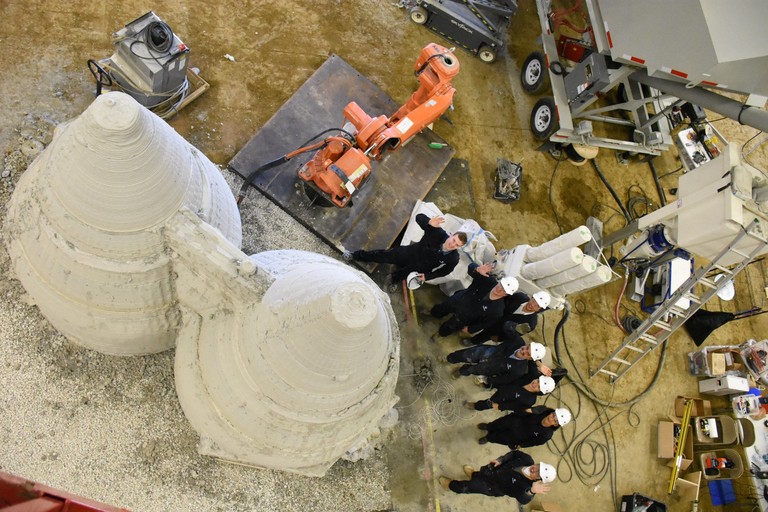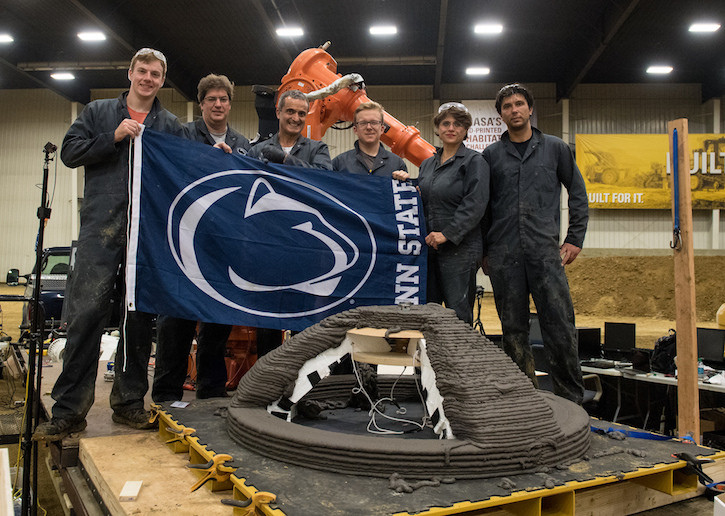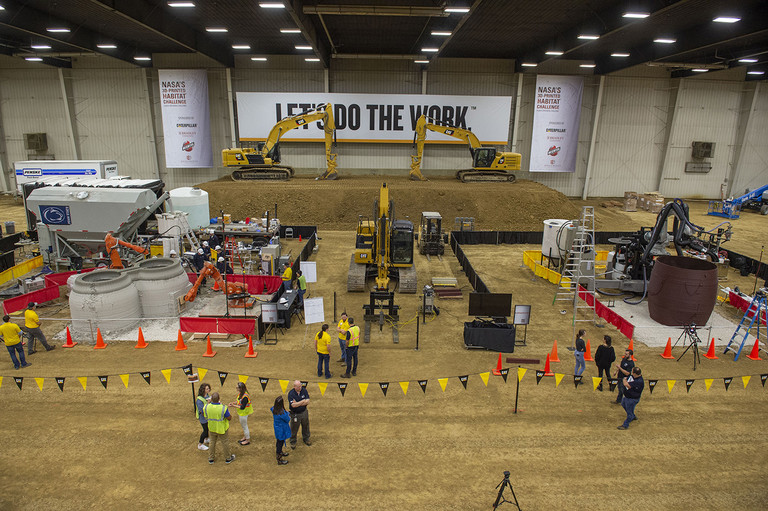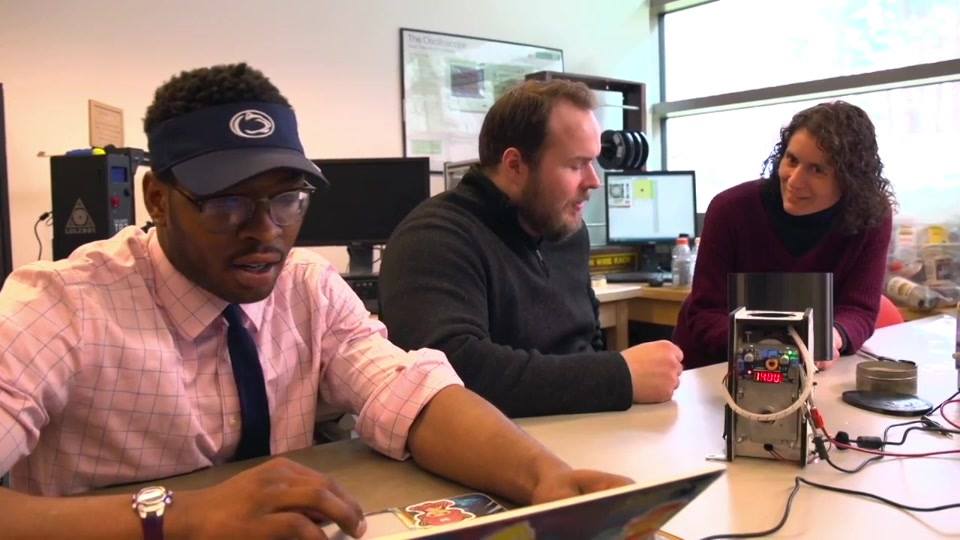Registration opens for ISS U.S. National Lab’s “Additive Manufacturing in Space” workshop
3D Printing News Briefs: February 21, 2020
In today’s 3D Printing News Briefs, we’re talking about new products and materials, an industry event, 3D printed electronics, and education. 3Doodler announced a new product, and Essentium will be showcasing two new materials at RAPID + TCT. The 4th annual AM Cluster of Ohio conference is coming up in July, and nScrypt is microdispensing 50um dots for 3D printed electronics. Finally, Penn State University is investing in Roboze technology.
3Doodler Introduces New 3D Build & Play
 At the New York Toy Fair, February 22-25 at Manhattan’s Jacob Javits Center, 3Doodler will be showcasing its latest device – the 3D Build & Play, perfect for preschoolers and kindergartners to use. The pen was designed for users as young as four years old, and introduces growing children to 3D printing technology in a way that promotes cognitive and fine motor skills development, hands-on learning, story telling, and three-dimensional thinking. The 3D Build & Play is kid-safe, extruding low-heat, BPA-free, non-toxic, biodegradable plastic, and comes with a story-based Activity Guide so parents and kids can create together. Currently available for pre-order, 3D Build & Play will have an MSRP of $29.99, and major retailers, like Amazon, are also expected to carry the product in Q2 2020. Visit 3Doodler in Booth #2771 at the New York Toy Fair to learn more.
At the New York Toy Fair, February 22-25 at Manhattan’s Jacob Javits Center, 3Doodler will be showcasing its latest device – the 3D Build & Play, perfect for preschoolers and kindergartners to use. The pen was designed for users as young as four years old, and introduces growing children to 3D printing technology in a way that promotes cognitive and fine motor skills development, hands-on learning, story telling, and three-dimensional thinking. The 3D Build & Play is kid-safe, extruding low-heat, BPA-free, non-toxic, biodegradable plastic, and comes with a story-based Activity Guide so parents and kids can create together. Currently available for pre-order, 3D Build & Play will have an MSRP of $29.99, and major retailers, like Amazon, are also expected to carry the product in Q2 2020. Visit 3Doodler in Booth #2771 at the New York Toy Fair to learn more.
“3D Build & Play brings the creative fun of our Start pen without the learning curve for the youngest users. The system we have developed, that lets kids crank and create in 3D, is a major benefit for parents looking to improve their children’s basic motor skills. The included molds make it easy to create 3D objects by simply filling and popping them out. There’s nothing on the market today that makes 3D creation this simple or fast for young creators,” said 3Doodler’s CEO Daniel Cowen.
Essentium’s New Materials for High-Temperature Applications
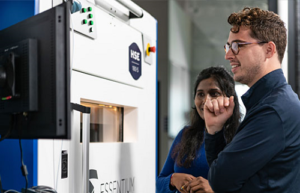 At RAPID + TCT 2020 in Anaheim this spring, 3D printing solutions provider Essentium will introduce new ULTEM AM9085F and ABS materials for high-temperature industrial AM applications. These high-performance materials, which will be showcased on the company’s High Speed Extrusion platform at the event, provide high strength and have excellent resistance to heat and chemicals at high temperatures, so they can be used for applications in the aerospace, automotive, industrial, and medical industries.
At RAPID + TCT 2020 in Anaheim this spring, 3D printing solutions provider Essentium will introduce new ULTEM AM9085F and ABS materials for high-temperature industrial AM applications. These high-performance materials, which will be showcased on the company’s High Speed Extrusion platform at the event, provide high strength and have excellent resistance to heat and chemicals at high temperatures, so they can be used for applications in the aerospace, automotive, industrial, and medical industries.
According to a survey commissioned by Essentium, 51% of executives believe that the high cost of materials is a major obstacle when it comes to adopting 3D printing for large-scale production purposes. The new ULTEM AM9085F and ABS materials were created to give manufacturers a more cost-effective solution when compared to expensive closed-system materials. Learn more at Essentium’s Booth #3400 at RAPID + TCT in Anaheim, CA, April 20-23, 2020.
4th Annual Additive Manufacturing Cluster of Ohio Conference
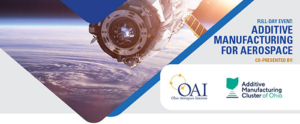 The Additive Manufacturing Cluster of Ohio, powered by organizations such as America Makes and the Youngstown Business Incubator, has announced that its 4th annual conference will take place this summer in Cleveland. Cluster members work together to create a supply chain of interconnected institutions and businesses to advance regional growth in 3D printing. This conference, to be held on Thursday, July 30, at the Embassy Suites by Hilton Cleveland Rockside, will be the first cluster event of 2020, and will give Ohio manufacturers of multiple business models and sizes perspectives on available opportunities for adopting 3D printing into their process chain over the next five years.
The Additive Manufacturing Cluster of Ohio, powered by organizations such as America Makes and the Youngstown Business Incubator, has announced that its 4th annual conference will take place this summer in Cleveland. Cluster members work together to create a supply chain of interconnected institutions and businesses to advance regional growth in 3D printing. This conference, to be held on Thursday, July 30, at the Embassy Suites by Hilton Cleveland Rockside, will be the first cluster event of 2020, and will give Ohio manufacturers of multiple business models and sizes perspectives on available opportunities for adopting 3D printing into their process chain over the next five years.
The website states, “The program will look at similarities and differences across several selected manufacturer types and will identify strategies ranging from low to high risk. Attendees will leave with actionable strategies and information about regional resources to help them remain competitive in the evolving manufacturing landscape.”
nScrypt Working with 3D Printed Electronics
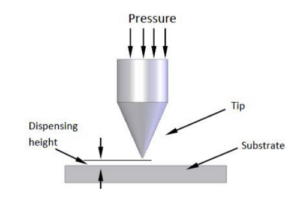 Orlando company nScrypt is working with precision microdispensing, an additive method of dispensing pastes, inks, and other fluid materials, to create adhesive dots with volumetric control, in the 50 micron range, for 3D printed electronics and flexible hybrid electronics (FHE). Microdispensing gets much closer to the substrate surface when compared to methods like jetting, and the closer the nozzle is to the surface, the finer the features of the 3D printed parts. The team used the nScrypt SmartPump, a silicone adhesive, a conical pen tip, and Heraeus SAC305-8XM8-D Type IX solder paste, and tested the consistency and repeatability of ~50µm Type IX solder and adhesive dots.
Orlando company nScrypt is working with precision microdispensing, an additive method of dispensing pastes, inks, and other fluid materials, to create adhesive dots with volumetric control, in the 50 micron range, for 3D printed electronics and flexible hybrid electronics (FHE). Microdispensing gets much closer to the substrate surface when compared to methods like jetting, and the closer the nozzle is to the surface, the finer the features of the 3D printed parts. The team used the nScrypt SmartPump, a silicone adhesive, a conical pen tip, and Heraeus SAC305-8XM8-D Type IX solder paste, and tested the consistency and repeatability of ~50µm Type IX solder and adhesive dots.
These tests showed a consistent average dot diameter of 51.24 microns, with a 6.42 micron (13%) standard deviation. These results support the fabrication of 3D printed electronics through the use of direct digital manufacturing (DDM), which allows printing to both planar substrates and the non-planar world of Printed Circuit Structures, which prints the housing or structure of an electronic device as well as placing the electronics conformally. In the future, the team plans to conduct a larger solder and adhesive dot study, in order to test required downtime, long-term reliability, and the frequency of clogging.
Penn State University Invests in Roboze Technology
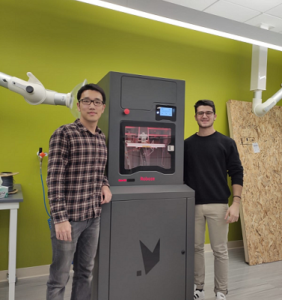 Penn State, a 3D printing leader through its Center for Innovative Materials Processing through Direct Digital Deposition (CIMP-3D), has invested in a new FFF solution in order to expand its AM capabilities. The ROBOZE One+400 Xtreme 3D printer, which was designed to create high performing, functional finished parts in advanced composite materials, will help the university increase its development of high performance plastics for 3D printing, and will be housed in the Department of Chemical Engineering. Students will be able to test out new polymers on the system, and develop new formulations to provide 3D printed parts with multi-functionality. These parts will be used to advance research in applications like chemical reactors.
Penn State, a 3D printing leader through its Center for Innovative Materials Processing through Direct Digital Deposition (CIMP-3D), has invested in a new FFF solution in order to expand its AM capabilities. The ROBOZE One+400 Xtreme 3D printer, which was designed to create high performing, functional finished parts in advanced composite materials, will help the university increase its development of high performance plastics for 3D printing, and will be housed in the Department of Chemical Engineering. Students will be able to test out new polymers on the system, and develop new formulations to provide 3D printed parts with multi-functionality. These parts will be used to advance research in applications like chemical reactors.
“ROBOZE One+400 Xtreme will be used to examine novel polymers to help to fundamentally understand the 3D printing process and as a tool to enable custom equipment more cost effectively than can be obtained with machining metals while also allowing for designs not possible with traditional manufacture. The ROBOZE One+400 Xtreme will allow Penn State to leverage its expertise in materials science, engineering and characterization to enable new solutions to problems through additive manufacturing,” said Professor Bryan D. Vogt from the Department of Chemical Engineering.
“The ability to use custom filaments and control the print processing was a critical factor in selecting ROBOZE. The flexibility allowed by ROBOZE along with its excellent printing capabilities is well aligned with the discovery-oriented research mission of the university to expand knowledge and its application. Moverover, our prior 3D printer had issues printing high temperature engineering plastics like PEEK with severe deformation of the structure generally observed. After challenges with printing PEEK with standard belt driven systems, the novel direct drive approach with the ROBOZE was an added bonus.”
Discuss these stories and other 3D printing topics at 3DPrintBoard.com or share your thoughts in the Facebook comments below.
The post 3D Printing News Briefs: February 21, 2020 appeared first on 3DPrint.com | The Voice of 3D Printing / Additive Manufacturing.
Penn State launches graduate course to help engineers tackle IP issues in 3D printing
Penn State Creates a Breakthrough 3D Printing Technology for the NASA Housing Challenge
In 2017, just a few months before his death, theoretical physicist Stephen Hawking said humanity only has about 100 years to escape Earth. Even though we have seen the signs alerting us that life on this planet is ailing, with plastic conquering the oceans, thousands of animal species becoming extinct and a shortage of water that affects every continent, the conversion towards a fully sustainable lifestyle that could revert the feeble state of our home is just not happening. So, many are actually paying attention and heeding Hawkins advice, trying to look for other “celestial bodies”, to conquer. One of the first to announce they were looking for volunteers to travel to the red planet was Mars One back in 2013, with over 200,000 people from 140 countries applying for a one-way ticket to join a human settlement on Mars by 2023. Millions of dollars later, Mars One went bankrupt showing us all how challenging developing the technology for Mars would be. Happily, they are not the only ones, four years ago, NASA outlined a plan to land humans on the surface of Mars by 2030, and world-renowned investor Elon Musk already has a timeline for colonizing Mars. The race is on to develop the technology, space shuttles, and medicine that will take the first settlers. One key challenge is housing of course, which is why NASA hosted the 3D printing habitat challenge, a four-part massive event that began in 2015 and created a competition among citizen inventors to use readily available and recyclable materials to print habitats useful for Mars colonization. Additionally, these discoveries in science and technology can also be adapted to improve life on Earth. During the final phase, runner up team Pennsylvania State University of University Park, was awarded $200,000 for their work. The interdisciplinary team of students and faculty from the Colleges of Arts and Architecture, Engineering, Agricultural Sciences, and the Materials Research Institute, have worked arduously during the last few years on this challenge and in the process, they engineered a breakthrough that moves forward 3D printing construction research and pushes the team closer to the goal of creating sustainable housing on Earth.
The four-phase competition requires entrants to develop advanced 3D printing technology, including the mechanical elements of the printer and a cement mixture using indigenous materials, to produce a structurally sound habitat that can be 3D printed by NASA’s space explorers on Mars. During the final phase, which took place on the first week of May, and after 30 hours of 3D printing, with nearly 200 spectators gathered at Caterpillar Edwards Demonstration and Learning Center in Peoria, two teams competed side by side, PennStateDen@Mars (the only university team in the competition) and AI SpaceFactory, culminating with the final print of each team’s structure. And although the Penn State team didn’t win phase-three of the competition, they returned to University Park having developed 3D printed home construction technology that could impact construction or help rebuild areas ravaged by natural disasters.
“Printing an enclosed roof has never been done before,” said José Duarte, Penn State team leader and director of the Stuckeman Center for Design Computing. “It was an amazing feeling and the success really highlighted the collaborative nature of the team. We had big dreams and because of everyone involved, they became a reality. We definitely feel a sense of social responsibility with this research. We are dealing with an environment quite different than ours.”
NASA’s encounter has generated many experiments, challenges and innovative results, helping 3D technology advance into uncharted territory, and Mars or any other planet humans intend to inhabit in the future will be a difficult endeavour. Mars is a rocky planet with volcanoes, canyons, limited access to water and a very thin atmosphere made of carbon dioxide, nitrogen, and argon. It’s similar to Earth in some ways, but you might need to suit up before wandering around the terrain, let alone try to build your own home. According to NASA it’s a tough place to live, but thanks to the knowledge and understanding gained through these competitions, we might get a little bit closer to conducting live printing experiments on site.
Associate professor of architecture and fellow team leader, Shadi Nazarian, also believes that the technology could be life-changing for many people:
“Imagine an area that was devastated by a tornado; this type of technology could be sent to that area and shelters can be immediately printed for those who lost everything. This thinking drives our research and feels much more attainable with our latest achievement. The applications of the materials and techniques that we and our competitors have developed are many, including immediate possibilities for building with materials that are gentler to the environment, use indigenous and recyclable materials, and withstand harsh conditions here on Earth and beyond,” Nazarian suggested.
The Penn State team, led by Duarte and Nazarian, was originally selected to take part of the competition from an initial entry pool of 77 teams. PennStateDen@Mars was one of only five teams who qualified to participate in the Centennial Challenge. In both phases of the contest, the participants had to 3D print structural habitat pieces in no more than four days, that were evaluated and then crush-tested on site, using some of Caterpillar’s most overwhelming construction machines. During the event, the team faced the challenge of creating robots to build the habitat. The team was very successful, finishing in second place in phase two and second and third place in construction levels one and two of phase three of the competition, generating nearly $300,000 in prize money.
The PennStateDen@Mars entry to the competition was based on previous research aimed at developing functionally graded materials and verifying the possibility of designing and constructing seamless buildings, which can have a significant impact on architectural language and building processes. They further developed additive-manufacturing technology to 3D print habitats using a specially formulated concrete made from materials that can be found on Mars. But Penn State being selected for this challenge has also a lot to do with their experience and innovation in 3D printing. They have many 3D printing labs on campus, like the Maker Commons, which houses a large-scale printing installation of 32 desktop 3D printers as well as the Invention Studio; university researchers delved into 4D Printing with Wood Composites for architectural applications, while a Penn State startup, Trimatis LLC, hopes to help the planet with recycled filament and the university also created VenturePointe, a new startup incubator for urban campus Penn State Shenango, complete with 3D printers. Both Nazarian and Duarte have been doing research with materials and 3D printing in the past, resulting in the development of innovative and graded material interfaces, which would enable the design of seamless shelters and impermeable bonds between glass and geopolymer concrete to protect individuals and the climate inside the habitat.
“The Mars competition has given us the opportunity to expand our understanding of 3D printing in ways we didn’t consider,” Nazarian said. “The result has been breakthroughs that can fundamentally change concrete construction. For example, 3D printing does not require formwork, which consumes much of the cost and labor in this industry. I’m excited about how this research helps advance the construction technology that is needed to create sustainable housing options.”
Team members focused their efforts in developing a novel concrete formulation, advancing 3D printing processes, and designing the overall 3D printing system necessary to print large structures. According to Penn State, the production of the geopolymer binder used in the formulation of the concrete designed by the team does not emit carbon dioxide into the atmosphere, unlike the production of the most common types of cement. Last year, assistant professor of civil engineering at Penn State, Alexandra Radlinska, along with NASA launched an experiment, the Microgravity Investigation of Cement Solidification – Multi-use Variable-gravity Platform (MICS-MVP), to examine cement samples aboard the International Space Station, which could have significant benefits for humans living on Earth and, eventually, the moon and Mars. Processing the samples provided with the fundamental baseline and insight regarding cement solidification in extraterrestrial bodies such as Mars.
The 3D Printed Habitat Challenge will resume next year and PennStateDen@Mars team is ready to advance the additive construction technology needed to create sustainable housing. In the meantime, they are looking to showcase their breakthrough in 3D printing for housing on campus, where a 3D printed tiny house could be constructed, which, according to the university, will be a fully sustainable building and offer a glimpse into the future of home construction.
Additive Manufacturing is being used widely to develop sustainable housing options. With countries like Singapore busy at work 3D printing public housing, as well as INNOPrint 3D, a French 3D printer that (unrealistically) claims it can print emergency housing in 30 minutes, looking to print homes for the first settlers to colonize Mars seems like the right direction for the technology. Many innovators, companies and governments are passionate about life on other planets, and Mars has qualities that experts consider similar to Earth, with challenges picking up the pace of 3D printing technologies used in construction, it might not be long before 3D printers are being shipped to Mars for some of the first construction experiences in outer space.
3D printing jobs update, 3Dexter, Simplify3D, Assembrix, Penn State University
Lot of One: Will Warehouses Sit Empty as 3D Printing Customization Kills Mass Manufacturing?
 John Jordan, of Penn State University, understands the vast implications of 3D printing technology on the world and industrial production. Manufacturing as we know it, along with how we create more complex geometries and present them, is being, and will be further disrupted by a technology allowing for innovations to be created faster, better, and more affordably—but also in ways we never expected before. Jordan focuses on the changes we will see in organizational design, concerning decisions in volume of production at the managerial level and which parts will be 3D printed, how options in customization will continue to grow, and what level of education will be required for businesses and their employees adopting new practices in the digital age.
John Jordan, of Penn State University, understands the vast implications of 3D printing technology on the world and industrial production. Manufacturing as we know it, along with how we create more complex geometries and present them, is being, and will be further disrupted by a technology allowing for innovations to be created faster, better, and more affordably—but also in ways we never expected before. Jordan focuses on the changes we will see in organizational design, concerning decisions in volume of production at the managerial level and which parts will be 3D printed, how options in customization will continue to grow, and what level of education will be required for businesses and their employees adopting new practices in the digital age.
Jordan is careful to evaluate 3D printing and its relative impact realistically, understanding there is no guarantee that it will ‘force a shift,’ or even begin to replace conventional mass production as we know it. He understands that humans, in their most basic forms of creating and manufacturing, have three choices: add, mold, or subtract. 3D printing and additive manufacturing have come along and offered us new choices for on-demand, on-site production—and often in remote locations; great examples of this are developing countries, military installations, and the oil and gas industry.
Opportunities are vast in customization, and Jordan points to examples in the hearing aid and orthodontic markets. The sudden availability of technology for producing complex geometries that can be created through 3D modeling and refined as needed, quickly and affordably, offers extensive latitude also—and not only to businesses but to anyone who is designing and engineering parts, pieces, or prototypes.
In his research, Jordan looks to industry automotive leaders like Mercedes and Porsche, both of which are making use of 3D printing in polymers and metal, as well as fabricating parts that have become obsolete and would be very difficult to order or find today.
“Moving the locus and scale of production in turn affects the size and activities of the purchasing organization, the inventory management function, and of course factories,” states Jordan. “Previously impossible repairs (such as rebuilding broken teeth on a large, complex, and/or obsolete gear) can become feasible. Forecasts may need to become much more granular, responsive, and localized to reflect smaller production facilities closer to end demand.”

3D printed engine by Porsche (photo: Formlabs)
Most consumers get excited about customizations. Just as 3D printing is allowing the medical field to become ‘patient-specific’ and allowing for a higher quality of life for patients, within the consumer realm, this means that shoes and a variety of different size-reliant purchases could feasibly in the future be tailor made every time. Undeniably, however, manufacturers and retailers—as well as buyers—are deeply entrenched in conventional processes, and Jordan predicts that ‘the supply chain will need to be reconceived and reconfigured, with significant organizational implications.’ He also states that currently the ‘defining capabilities’ of 3D printing are not being used to their potential, which many will concur with, and possibly consider it a vast understatement as well.
Jordan again brings forth the example of the hearing aid industry:
“To design a mass customization process from scratch, the key is to begin with unique units of demand: what is it that is being customized and to what parameters? The hearing aid market is instructive in this regard: local audiologists measure the customer’s hearing loss and ear dimensions, then feed this data into the process,” states Jordan. “In the absence of a steady stream of such customized orders, the ‘mass’ in mass customization fails to materialize at economically attractive levels. Where else can customizable goods find willing buyers, who can be served by fitters and configurators with access to 3D printing capacity in some shape or form?”
When business owners do realize that 3D printing is a possibility, and they begin expanding on the benefits, ‘processes are redefined.’ It is somewhat staggering to consider that with such extreme customization available, rather than lots of tens or hundreds or thousands, lots could commonly be reduced to just one.
Jordan envisions an ‘additive-native organization’ as one that will ‘give way to agile generalists,’ featuring products ‘closer to end customers’ and warehouses that will become quite empty due to consumers beginning to rely on items made specifically to their size and taste.
As an added boon for businesses and profitability levels, he also sees overall available capital increasing too as conventional and expensive methods such as tooling may not be necessary, and materials can be much cheaper, depending on the textile or metal.
“Finally, the capital investment in additive manufacturing equipment is highly adaptable: it is a thing that can make many different things. In contrast, stampers, molds, and dies are tightly constrained and difficult or impossible to adapt as market conditions change. Thus, the finance and accounting organization will face new parameters, potentially related to flexibility as well as cost,” states Jordan.
“These internal measures will eventually be judged by outside investors and analysts. Eventually, equity markets will expect new performance targets, so earnings guidance will evolve, putting pressure on traditional financial analysis and reporting.”
The availability of so many new materials is bringing 3D printing further into the fold also, and Jordan points to 3D printing in running shoes, with companies like Adidas and Carbon working together, as well as on the larger scale in aerospace with GE developing 3D printed aircraft engine nozzles.
GE’s forays are notable and vast in the 3D printing and additive manufacturing, but in the case of an innovation like the nozzles, GE demonstrates a long list of benefits from savings in cost, development time, and more, to include fuel expense. The elements of design involved are deemed inexpensive by Jordan, but financially, the ‘learning curve of parts consolidation’ would have to be navigated and in studying this project, Jordan makes the astute observation that if we look at 3D printing in the mass manufacturing mindset, there will be obstacles.

GE is 3D printing massive nozzles for aircraft engines. (Photo: GE Reports)
“Rather, with an expanded range of possibilities, existing assumptions will need to be tested. For example, in the realm of decentralization, 3D printing should not be assumed to drive most production from centralized facilities out to the periphery, but neither can centralization continue to be taken as the default. In short, each of the four domains [discussed] represents a set of decisions that organizational designers and managers will now need to address with conscious deliberation rather than previously constrained assumptions. The interrelationships among these domains of change—and others that will emerge—remain to be discovered,” states Jordan.
What do you think of this news? Let us know your thoughts! Join the discussion of this and other 3D printing topics at 3DPrintBoard.com.
Penn State Startup Trimatis LLC Hopes to Help the Planet with Recycled Filament
A common concern with 3D printing is how efficient it really is. The technology can produce parts locally saving on CO2 when compared to other technologies that have to be centralized. 3D printing also potentially creates parts that use up less material since the process builds the part up as needed along with perhaps some support. This in contrast to other technologies that cut away large amounts of material to create parts. What if we could make it greener and more efficient still? What if we could use plastic waste to make 3D printed parts? There are plenty of conscientious people out there, from startups to the military, putting forth efforts to create ways to reuse and recycle that waste plastic. There’s always a need for more recycling resources in the 3D printing world, and startup Trimatis LLC is ready to help.
Trimatis was formed at Penn State University by recent mechanical engineering graduate Jason Lehrer, current electro-mechanical engineering technology student Tito E. Orjih, and engineering faculty member Marietta R. Scanlon. The three of them were inspired to create the startup after seeing how much waste 3D printers generated – as well as how much waste was on the streets of Philadelphia.
“During my environmental stewardship internship, I witnessed a copious amount of plastic waste littering the streets of Philadelphia,” said Orjih. “Where people saw trash, I saw an opportunity to build a business and help the environment.”
After starting the company, Orjih and Lehrer applied for the 2018 PennTap Inc.U competition.
“We had to turn an idea that was proven in a lab into a business in a short period of time,” said Lehrer. “A lot of time was spent looking into the market to see if this would be a viable business.”
“We prepared by doing a lot of pitch practices in front of different people with different perspectives,” Orjih added. “Each practice pitch helped us address our mistakes and helped us understand how to adjust our pitch based on the audience.”

Penn State President Eric Barron, right, awards $2,000 at the 2018 Invent Penn State Venture & IP Conference to Orjih and Lehrer. [Image: Penn State]
After Inc.U, the pair pitched the company at the 2018 Invent Penn State Venture and IP Conference.
“Another humbling experience,” Orjih said. “The best part was networking with people from the crowd who generally loved what we were doing and wanted to support us.”
Invent Penn State has allowed many students to get businesses off the ground; in the past three years 21 innovation hubs have been funded in Pennsylvania as part of the initiative.
“The education and resources Penn State has provided have been instrumental to the development of the company,” said Scanlon. “The research Jason conducted during his participation in the Multi-Campus REU program sparked the idea. In addition, the Langan Launchbox, Penn State Berks’ innovation hub funded by the Invent Penn State grant, has provided countless resources to ensure the team’s success.”
Trimatis was recently selected as one of 10 finalists in the Great Social Enterprise Pitch, an idea incubator and business plan competition for startups aiming for a positive social or environmental impact. Trimatis has been participating in the incubator all summer and is now in the crowdfunding part of the competition.
“We plan to keep progressing, improving on our process, marketing and developing connections with people who will be assets to the company,” said Lehrer.
“Our eyes are on the official launch day,” Orjih said. “Our goal is to launch by Jan. 31, so we are taking the proper steps needed to finally be in business.”
If you’d like to support Trimatis, you can check out its crowdfunding campaign on Indiegogo.
Discuss this and other 3D printing topics at 3DPrintBoard.com or share your thoughts below.
[Source: Penn State]

